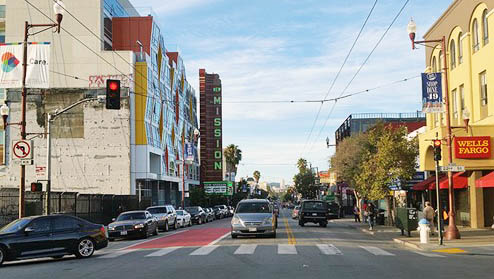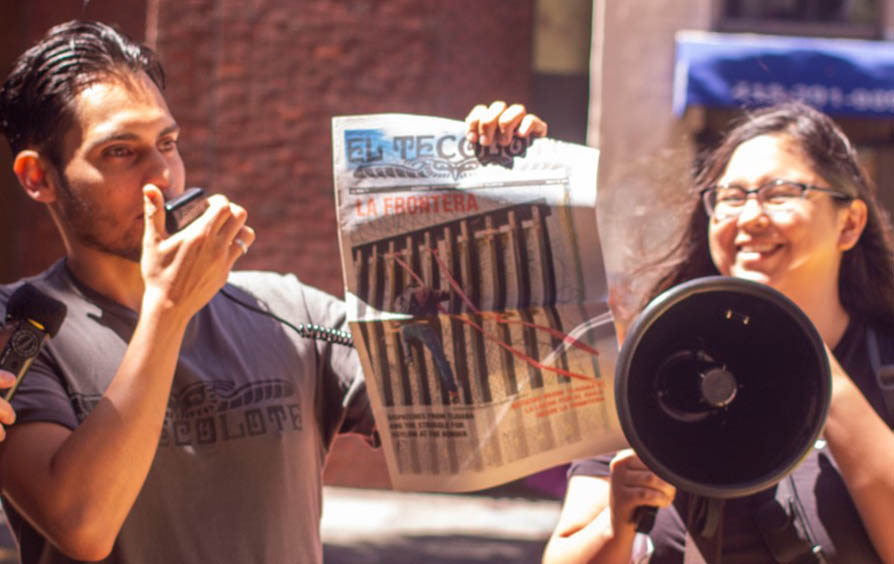|
|
|
|
The weekly newsletter of the México Solidarity Project |
|
|
|
June 15, 2022/ This week's issue/ Meizhu Lui, for the editorial team |
|
|
In San Francisco: Whose Mission? Our Mission! |
|
“Replacement theory” — the chilling idea that’s duped a frightening number of men among us into committing mass murders — asserts that the growing US presence of non-European people threatens white . . . well, white supremacy.
But if you live in what has been for generations a neighborhood of Blacks, Asians, or Latinx, you live the truth: Whites are replacing you, not working class whites, but affluent young professionals. Your families may have lived near the water back in the days when industries routinely dumped their toxic waste into rivers and oceans. Those wastes no longer foul that water. Your location has become primo. And if you live in the middle of a city like New York, Chicago, or San Francisco, your proximity to the city center has made your neighborhood newly desirable.
Two stalwarts of our México Solidarity Bulletin editorial crew, Oakland residents Vicky Hamlin and Agatha Hinman, talk this week with Alexis Terrazas, editor of El Tecolote, a community newspaper published in San Francisco, the city that ranks as our nation’s most gentrified urban area. El Tecolote has been tracking this gentrification trend, for good reason. Having a place to live continues to be the most important issue facing long-time residents of San Francisco’s historic Mission District, a community where Latinx have created their own vibrant cultural space.
Why did Mexicanos and other Latinx people originally settle here in the Mission? White US businesses had “replaced” their small farms and businesses back home. Yesterday and today, we see the same basic “replacement” story. To accommodate the US corporate chase after ever-greater profits — or the whims of affluents ever on the lookout for more fashionable locales — Latinx must migrate from place to place, across not just national borders, but neighborhood ones.
Mission residents are not taking this replacement lying down, and their community newspaper is working right there with them, spreading the news, challenging city hall. Whose Mission? Our Mission! Let’s cheer them on — until mission accomplished. |
|
|
|
Don’t miss an issue. Subscribe to the weekly México Solidarity Bulletin! |
|
|
|
|
A Community Paper Takes on Gentrification |
|
For eight years now, journalist Alexis Terrazas has been working as the editor-in-chief of El Tecolote, the community newspaper that's been serving the San Francisco Mission District since 1970. Published biweekly, El Tecolote currently rates as the longest-running Spanish/English bilingual newspaper in California. El Tecolote’s core mission: to reflect and serve its community, and no one brings more dedicated to that mission than Terrazas.
What led you into community journalism? |
|
|
I’m Mexican-American, my mother from Jalisco, my father and his parents all born in the Mission. I have strong connections to my mother’s family in Mexico, but also, as a child, my mother took me to this San Francisco Mission neighborhood all the time to go to the Western Union to send money home.
I learned journalism at San Francisco State, but basically considered myself a sportswriter when I got this job. I was really nervous because I saw I was following in a long line of amazing forward-thinking editors. An intimidating feeling — it took a whole year before I got comfortable! But I found I was where I belong: in community journalism.
Your paper has been serving Latinx for fifty years. But is the Mission still Latinx? Hasn’t it been gentrified?
Before WW II, the Mission was a neighborhood of mainly European immigrants — Italian, Irish, Scandinavian, and German. After the war, these immigrant families got loans and moved into more affluent areas, leaving all their Mission homes vacant. Mexican immigrants living in the South-of-Market area moved in. Later came Central-Americans, Caribbeans, and Puerto Ricans. But when these immigrants tried to get loans for businesses, the banks turned them down. |
|
Then speculators moved in, after the Mission become known as a hip, artistically beautiful neighborhood. The Latinx population that made the Mission beautiful — without the help of loans from racist banks — is now viewed as disposable. One study commissioned by city hall has looked at the Mission from 2005 to 2015. Those years saw 8,000 Latinx displaced, and that would only be the beginning. |
|
|
Photo: Chris Carlsson, 2016. After a fire burned the old Mission Market, |
|
What can the Latinx community do to stop gentrification?
During the pandemic we had programs to help people with their rents. But we found that a lot of Latinx, as immigrants, thought the programs didn’t apply to them. Yet interestingly enough, many of these immigrants had zero rent debt. One single mom had saved $20,000 just from restaurant work. How the hell did she save $20,000! You have to be creative to do that, very creative. But then she used up all her savings when she became unemployed.
In México, Los Topos — the moles — got started right after the 1985 earthquake, not a government agency, just ordinary people who came together voluntarily to dig. We see that same spirit alive and well here in the Mission. During Covid, this community right away organized a food hub and a Covid testing site at 24th and Capp Streets. People in our community have persevered through earthquakes, civil wars, and the pandemic. Many will find creative ways to survive gentrification too. |
|
How does El Tecolote serve the community?
We can tell the truth about what we see. We refuse donations to our nonprofit from companies that harm our people. We let people know their rights. In March, for example, San Francisco eviction protections expired. We have new ones, but you have to apply by a certain date. |
|
|
Photo: Vicky Hamlin, El Tecolote at a 2018 immigrant rights demonstration. |
|
That’s a problem for our monolingual Spanish-speakers. So what did we do? We collaborated with a multicultural housing justice organization, Causa Justa, and did a podcast with a housing rights coordinator, targeting Spanish-speaking renters. Our podcast explained everything you need to know, with contact information to housing rights organizations.
We want people to avoid evictions that will lead to more gentrification. And we participate in demonstrations and actions that demand justice, in things like immigration reform. We use our paper as a platform, identifying what our people need and what they can do. To do that, we see listening to the people as the most important thing we can do. With 10,000 readers, I guess that people after fifty years still feel that El Tecolote — “the owl” — serves as their ears and eyes. |
|
|
Morena Takes Governorships in Four More States |
|
In this year’s most important Mexican elections, held June 5 in six states, Morena scored a series of stunning successes. This México News Daily dispatch offers a breakdown.
The Morena party won four of six gubernatorial elections held Sunday, June 5, increasing the number of federal entities controlled by the ruling party to 20 (out of 32 states). Morena candidates triumphed in Hidalgo, Oaxaca, Quintana Roo, and Tamaulipas. |
|
Julio Menchaca secured between 60 and 63 percent of the vote in Hidalgo, about double that of PAN-PRI-PRD contender Carolina Viggiano. The result will bring PRI’s long-held control of Hidalgo to an end.
Salomón Jara achieved a similarly thumping victory in Oaxaca, attracting support from 58 to 61 percent of voters, over double that garnered by PRI-PRD candidate Alejandro Avilés.
Former Benito Juárez (Cancún) mayor Mara Lezama will be Quintana Roo’s first female governor after winning between 55 and 58 percent of the vote. PAN-PRD candidate Laura Fernández was a distant second with support in the range of 15 to 18 percent. |
|
|
Morena candidate Mara Lezama has become the first woman elected as governor in Quintana Ro. |
|
Américo Villareal, Morena’s candidate in Tamaulipas, triumphed over César Verástegui, who served as government secretary in the current PAN administration. Villareal . . . won 50 percent of the vote compared to 44 percent for Verástegui.
President López Obrador asserted Monday that the opposition’s “classism” was a factor . . . in the states won by Morena, a party he founded.
“I shouldn’t be giving advice . . . but they should carry out a review of their strategy, it affects them a lot . . . their classism, their racism” he told reporters at his morning news conference. “They show disdain for people, they have no love for people,” claimed López Obrador, who continues to enjoy a high approval rating 3 1/2 years after taking office. |
|
|
Recent news reports and commentaries, from progressive and mainstream media,
Manuel Pérez-Rocha, Latin American Leaders Gathering in Los Angeles Should Stand Up for People, Not Corporate Profits, Inequality.org. A Mexican fair trade activist reflects on the past two decades of battles against neoliberalism and for a more just and equitable alternative.
Luis Pablo Beauregard, Marcelo Ebrard: “La ausencia de López Obrador es una forma de mostrar que este arreglo no puede seguir así,” El País. El canciller mexicano defiende desde la Cumbre de las Américas la decisión del mandatario de no asistir a la reunión.
Election results spell complications for the opposition in 2024, México News Daily. Notes political scientist Arturo Sánchez Gutiérrez: “Morena has managed to recreate some of the PRI’s dominance but with the key difference that the current elections are democratic.”
Craig Mellow, Mexico’s Market Could Be a Haven From Global Volatility, Barron’s. With Morena’s latest gubernatorial victories, the global investor class increasingly sees México as a safe place to invest, especially since “AMLO lacks the parliamentary supermajority he needs to enact his most antimarket reforms.”
Carole Browner and Gustavo Leal Fernández, The Mexican Health Care System Under the Administration of AMLO, NACLA. Upon taking office, López Obrador promised to transform Mexico’s health care system and provide long-promised universal coverage.
Ulises Rodríguez López, AMLO rescata a la empresa Altán para dar internet gratuito a todo México, Polemón. López Obrador hizo su primer rescate a una empresa privada, el de Altán Redes. Con esto garantizaría internet gratuito para todo México en el futuro cercano.
Gustaf Kilander, Mexican President shares video of Ted Cruz, mocking him as an NRA stooge, at press conference, Independent. Obrador also played a Sky News clip during the press conference, showing Cruz walking away as a reporter presses him on gun reform after the school shooting in Uvalde, Texas. |
|
|
The Mexico Solidarity Project brings together activists from various socialist and left organizations and individuals committed to worker and global justice who see the 2018 election of Andrés Manuel López Obrador as president of México as a watershed moment. AMLO and his progressive Morena party aim to end generations of corruption, impoverishment, and subservience to US interests. Our Project supports not just Morena, but all Mexicans struggling for basic rights, and opposes US efforts to undermine organizing and México’s national sovereignty.
Editorial committee: Meizhu Lui, Bruce Hobson, Bill Gallegos, Sam Pizzigati, Courtney Childs, Victoria Hamlin, Agatha Hinman, Steven Hollis. To give feedback or get involved yourself, please email us! |
|
|
|
Web page and application support for the México Solidarity Project from NOVA Web Development, a democratically run, worker-owned and operated cooperative focused on developing free software tools for progressive organizations. |









